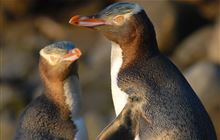Mixed results for yellow-eyed penguin/hoiho on mainland, decline on Rakiura
Archived content: This media release was accurate on the date of publication.
Introduction
Hoiho/yellow-eyed penguin numbers on mainland New Zealand are marginally up on last year’s but ongoing threats and emerging diseases continue to plague the struggling population.Date: 10 December 2020
Ngāi Tahu and DOC alongside the Yellow-eyed Penguin Trust (YEPT) have today released the season’s mainland hoiho numbers which estimates a minimum 177 breeding pairs on the coast between Oamaru and Curio Bay – 10 more than last season.
Three nests were also recorded on Banks Peninsula, up two on last year.
DOC southern South Island operations director Aaron Fleming says while it is good to see the mainland numbers haven’t declined this year, all is not well for this vulnerable species.
“While there have been some gains at some locations – north Otago has had a 15% increase in numbers, other places have had losses; Nugget Point for example recorded just two breeding pairs this year compared to 4 last year.
“There is no room for complacency. We’re working hard with Ngāi Tahu, YEPT and a range of partners and volunteers to turn things around for hoiho and stop the decline on the mainland.”
While the mainland numbers have been documented annually over the past decade, the last comprehensive survey on the Rakiura/Stewart Island population was done during the 2008/09 season.
To update that data, the YEPT, supported by DOC and Ngāi Tahu worked with contractors and researchers on a hoiho nest survey of the island, designed to be comparable with the 2008/09 seasons.
Preliminary results found 39 nests, compared with 153 in 2008/09 and 186 in 1999/00.
YEPT General Manager Sue Murray says while the decline does mirror what’s been documented on the mainland over the same time period, it is a stark and confronting picture for the species.
“The findings of the 2020 nest survey show that hoiho numbers have substantially declined throughout mainland Rakiura.
“These findings highlight the importance of studying how hoiho fare while foraging at sea, for which very little data is available around Rakiura.”
Te Rūnanga o Ngāi Tahu hoiho species recovery representative Yvette Couch-Lewis says the declining numbers are hugely concerning.
“There are no two ways about it. Continued action is needed if we are to have any hope of recovering the species.”
“This is about the manu, it’s not about people. We must put the manu first, when we’re heading down the pathway that we are with this species right on the decline, the focus must be on the bird and that’s what whānau are doing out in the field. We know how disheartening it is to see these results so for the Governance group it is critical we are refocusing on how we can better support all the whānau groups who are out there on the ground doing the mahi to protect this bird.”
Hoiho face a range of threats both on land and at sea. This year in particular has seen ongoing issues with diseases such as diphtheria and an emerging unknown form of lung congestion affecting chick survival.
To reverse the decline, Ngāi Tahu, Yellow-eyed Penguin Trust, MPI and DOC released Te Kaweka Takohaka mō te Hoiho and Te Mahere Rima Tau (Hoiho recovery strategy and 5 year action plan) in August.
Priorities in the strategy and action plan focus on managing human activities and disturbance and reducing impacts in marine and terrestrial habitats.
Aaron Fleming says many partners, volunteers and community groups play a crucial role to help the fight against extinction.
“This can be everything from landowners protecting and restoring habitat, groups who support with monitoring, intervention and rehabilitation or even those that give up their time to help with advocacy and awareness. It’s a huge, collective effort - we wouldn’t be able to achieve anywhere near as much for hoiho without them.
“We’re grateful to the many volunteers associated with hoiho and especially to the Wildlife Hospital and rehabilitation groups such as Penguin Place and Penguin Rescue for their efforts to help as many of these vulnerable chicks through the first few weeks of their life as possible.”
Background information
Everyone can do their bit to help out this iconic species. As the weather warms up and people spend more time on the beaches, they can help our precious wildlife by giving them plenty of space, paying attention to any alerts and signs, keeping dogs on a lead and under control and spreading the word to others in the area.
The draft Te Kaweka Takohaka mō te Hoiho was released for public comment in September 2019. The partners then revised the strategy and action plan to take account of feedback in submissions. The strategy is the first to follow the partnership approach and underlines the united effort to protect and restore the species.
Contact
For media enquiries contact:
Email: media@doc.govt.nz

